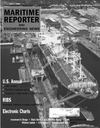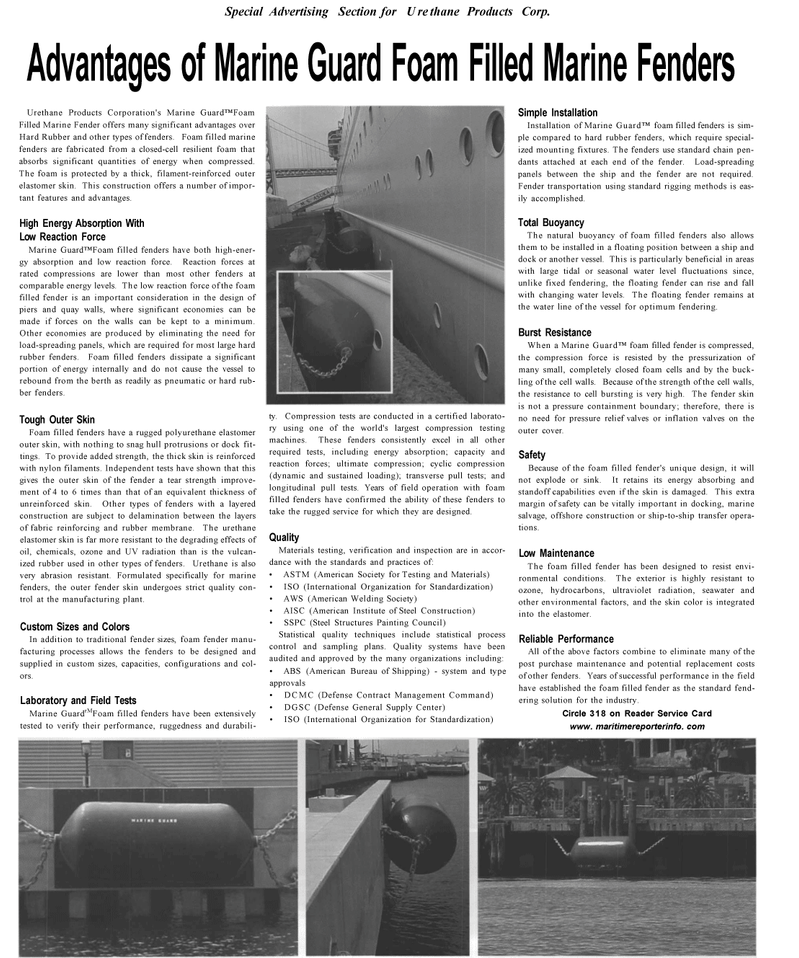
Page 46: of Maritime Reporter Magazine (August 2001)
Read this page in Pdf, Flash or Html5 edition of August 2001 Maritime Reporter Magazine
Special Advertising Section for U re thane Products Corp.
Advantages of Marine Guard Foam Filled Marine Fenders
Urethane Products Corporation's Marine Guard™Foam
Filled Marine Fender offers many significant advantages over
Hard Rubber and other types of fenders. Foam filled marine fenders are fabricated from a closed-cell resilient foam that absorbs significant quantities of energy when compressed.
The foam is protected by a thick, filament-reinforced outer elastomer skin. This construction offers a number of impor- tant features and advantages.
High Energy Absorption With
Low Reaction Force
Marine Guard™Foam filled fenders have both high-ener- gy absorption and low reaction force. Reaction forces at rated compressions are lower than most other fenders at comparable energy levels. The low reaction force of the foam filled fender is an important consideration in the design of piers and quay walls, where significant economies can be made if forces on the walls can be kept to a minimum.
Other economies are produced by eliminating the need for load-spreading panels, which are required for most large hard rubber fenders. Foam filled fenders dissipate a significant portion of energy internally and do not cause the vessel to rebound from the berth as readily as pneumatic or hard rub- ber fenders.
Tough Outer Skin
Foam filled fenders have a rugged polyurethane elastomer outer skin, with nothing to snag hull protrusions or dock fit- tings. To provide added strength, the thick skin is reinforced with nylon filaments. Independent tests have shown that this gives the outer skin of the fender a tear strength improve- ment of 4 to 6 times than that of an equivalent thickness of unreinforced skin. Other types of fenders with a layered construction are subject to delamination between the layers of fabric reinforcing and rubber membrane. The urethane elastomer skin is far more resistant to the degrading effects of oil, chemicals, ozone and UV radiation than is the vulcan- ized rubber used in other types of fenders. Urethane is also very abrasion resistant. Formulated specifically for marine fenders, the outer fender skin undergoes strict quality con- trol at the manufacturing plant.
Custom Sizes and Colors
In addition to traditional fender sizes, foam fender manu- facturing processes allows the fenders to be designed and supplied in custom sizes, capacities, configurations and col- ors.
Laboratory and Field Tests
Marine GuardrMFoam filled fenders have been extensively tested to verify their performance, ruggedness and durabili- ty. Compression tests are conducted in a certified laborato- ry using one of the world's largest compression testing machines. These fenders consistently excel in all other required tests, including energy absorption; capacity and reaction forces; ultimate compression; cyclic compression (dynamic and sustained loading); transverse pull tests; and longitudinal pull tests. Years of field operation with foam filled fenders have confirmed the ability of these fenders to take the rugged service for which they are designed.
Quality
Materials testing, verification and inspection are in accor- dance with the standards and practices of: • ASTM (American Society for Testing and Materials) • ISO (International Organization for Standardization) • AWS (American Welding Society) • AISC (American Institute of Steel Construction) • SSPC (Steel Structures Painting Council)
Statistical quality techniques include statistical process control and sampling plans. Quality systems have been audited and approved by the many organizations including: • ABS (American Bureau of Shipping) - system and type approvals • DCMC (Defense Contract Management Command) • DGSC (Defense General Supply Center) • ISO (International Organization for Standardization)
Simple Installation
Installation of Marine Guard™ foam filled fenders is sim- ple compared to hard rubber fenders, which require special- ized mounting fixtures. The fenders use standard chain pen- dants attached at each end of the fender. Load-spreading panels between the ship and the fender are not required.
Fender transportation using standard rigging methods is eas- ily accomplished.
Total Buoyancy
The natural buoyancy of foam filled fenders also allows them to be installed in a floating position between a ship and dock or another vessel. This is particularly beneficial in areas with large tidal or seasonal water level fluctuations since, unlike fixed fendering, the floating fender can rise and fall with changing water levels. The floating fender remains at the water line of the vessel for optimum fendering.
Burst Resistance
When a Marine Guard™ foam filled fender is compressed, the compression force is resisted by the pressurization of many small, completely closed foam cells and by the buck- ling of the cell walls. Because of the strength of the cell walls, the resistance to cell bursting is very high. The fender skin is not a pressure containment boundary; therefore, there is no need for pressure relief valves or inflation valves on the outer cover.
Safety
Because of the foam filled fender's unique design, it will not explode or sink. It retains its energy absorbing and standoff capabilities even if the skin is damaged. This extra margin of safety can be vitally important in docking, marine salvage, offshore construction or ship-to-ship transfer opera- tions.
Low Maintenance
The foam filled fender has been designed to resist envi- ronmental conditions. The exterior is highly resistant to ozone, hydrocarbons, ultraviolet radiation, seawater and other environmental factors, and the skin color is integrated into the elastomer.
Reliable Performance
All of the above factors combine to eliminate many of the post purchase maintenance and potential replacement costs of other fenders. Years of successful performance in the field have established the foam filled fender as the standard fend- ering solution for the industry.
Circle 318 on Reader Service Card www. maritimereporterinfo. com

 45
45

 47
47
